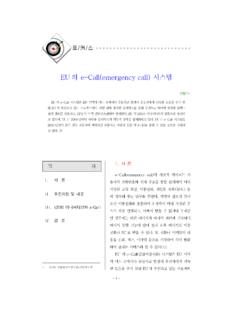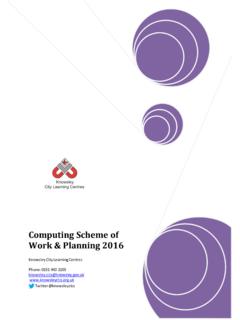Transcription of eSafety First Responders Guide
1 Updated September 2012 Page 1 of 15 eSafety First Responders Guide Further guidance on responding to an eSafety incident 1. Introduction 2. First response to an eSafety incident Step 1 Preserve the evidence Step 2 Pass it on - seek help and advice Step 3 Prevent it re-occurring Appendices Appendix 1 Police response to potential crime in school Appendix 2 Examples of responses to specific incidents Appendix 3 Some legal context (July 2011) Sources of Support Local Contacts Duty and Assessment Children s Social Care (for safeguarding advice, referrals) 01924 326097, 01924 326076, 01924 431429 Emergency Duty Services (out of hours safeguarding concerns) 01484 414933 LADO (for concerns about staff/volunteers) 01484 226748 07973 490746 IT service desk (Kirklees Council employees only) 01484 414714 (internal 860 46888) Local Advice Safeguarding Officers Schools and Learning 07528 252025, 07816 956670 ITCAS, ICT Schools and Learning Team 01484 225724 Learning service Out of School Clubs/Early Years 07528 988728 Young People s Service 01484 22516, 07866 692410 Libraries 01484 416976 Foster Carers 01924 483780 Police, Community Cohesion Officer 07595 006960 National Contacts Police (Non emergency 101) CEOP ( Child Exploitation and Online Protection) Professionals Online Helpline 0844 381 4772 Useful websites Kirklees Safeguarding Children Board Yorkshire and Humberside Grid for Learning (YHGfL) Think U Know (CEOP) resources and information Updated September 2012 Page 2 of 15 1.
2 Introduction This guidance has been produce to support any member of staff who may have to deal with an eSafety incident. An eSafety incident may fall into one of the following types: Inappropriate conduct: o posting material on social networks which contravenes work guidelines o inappropriate use of work email/internet o inappropriate use of a mobile phone or electronic device o password and account misuse ( use of someone else s password or login) Accessing unsuitable content: o downloading and / or viewing illegal material o downloading or view material unsuitable to the workplace o deliberately accessing content that expresses extreme or racists views Inadvisable contact: o giving away too much information o breaching client privacy o unsettling or threatening messages; cyberbullying o grooming behaviour or inappropriate contact with young people o misrepresentation, defaming Loss of confidential data o As a result of theft or loss of computer, laptop or memory stick 2.
3 First response to an eSafety incident Guidance for the First person at the scene of an eSafety incident has been published in the form of a wallet card and poster. It presents the options succinctly under three headings: Step 1 Preserve the evidence Step 2 Pass it on seek help or support Step 3 Prevent it re-occurring Immediate action will involve making a judgement on the seriousness of the incident, preventing children coming into contact with unsuitable material and seeking appropriate help and support. Dealing with an incident may involve outside agencies or may be resolved by the school s senior leadership and internal disciplinary procedures. Once the situation has been dealt with, then a full review will need to be initiated to take any action required to prevent the situation happening again. Each of these areas is dealt with in more detail below. Updated September 2012 Page 3 of 15 Step 1 Preserving the evidence If the incident involves the unacceptable, inappropriate or possibly illegal use of a computer, mobile phone or camera then it is important to preserve any evidence which may be currently on the device.
4 Make sure that other children or young people do not come into contact with the device. In particular the discovery of indecent images or videos involving children should always result in taking advice from the police. Immediate action to take: Turn off the monitor screen to prevent it being seen by bystanders or confiscate the device and prevent it being used again. Lock it away. Schools have the power to confiscate and examine the contents of a mobile phone or device if they believe it has been used for any purpose which breaks school rules Preserving technical evidence When preserving evidence it is advisable to seek technical support First and to have any actions either witnessed or supervised so that the chain of evidence can be corroborated. In addition make sure a record is kept of the step by step actions taken. If the device is on Take photos or video of the screen rather than printing it out (but print if you have to) unless the photograph would be of an indecent image of a child under 18 , when taking a photograph would itself count as a criminal offence Save open files, emails or messages to external media Avoid saving things locally (to local disk or internal memory) Do not shut down the computer (which can remove evidence such as history information, temporary files etc).
5 Seek technical advice If the device is off Make an external examination and take photos Do not start the computer/device Lock it away Seek technical advice If the content is on a shared network then the device should be taken out of service until an investigation can be completed by a technically competent person. Someone acting in a technical capacity, with written instruction and supervision in a case that may become a criminal investigation has a defence in law when necessarily handling these materials to preserve evidence, see: Updated September 2012 Page 4 of 15 Step 2 - Pass it on seek help or support to decide if the incident needs to be referred to other agencies (DSP,LADO, HT, Police, parents, HR) First contact with an incident could be: Something witnessed on a computer, mobile phone or camera A statement made by the victim Information from a bystander or witness about events or pointing to evidence that something untoward has happened Hearsay (rumour) about a potential situation Noticing an anomaly in a log, history using Internet Explorer Depending on the incident and the setting in which it occurred, report to.
6 Line manager or a senior member of staff Safeguarding Officer /DSP LADO Police 101 (see later guidance) Technical support (in Kirklees the IT support desk 01484 414714 external or 860 46888 internal) CEOP Parents /carers Other external support. the Professionals Online Safety helpline (0844 3814772 All the following incidents indicate the need to consult external support a. Concerns about the safety or well being of a child If there is a concern for the safety or well being of a child, because there are suspicions, signs or symptoms of child abuse or harm, the normal Safeguarding Children Board Procedures must be followed. These procedures are outlined in The Kirklees Safeguarding Children s Board Procedures and Guidance with special reference to ICT in Section Child Abuse and Information Communication Technology b. Concern with regard to the behaviour of someone who works with children This may be because that person has Behaved in a way which has harmed a child, or may have harmed a child Possibly committed a criminal offence against or related to a child ( by being abusive or grooming a child for later abuse) Behaved towards a child or children in a way which indicates that he/she is unsuitable to work with children Has viewed or taken pictures of children or young people which make you feel uncomfortable The Local Authority Designated Officer (LADO) must be informed.)
7 ( this should be used for anyone who works with children, not just local authority employees). These procedures can be found in Allegations against Persons who Work with Children Updated September 2012 Page 5 of 15 c. Concerns about criminal behaviour The following triggers should result in the police being contacted: Actual harm caused by violence, abuse or harassment or evidence that has occurred or is being incited or planned, including menacing behaviour, incitement, grooming or accessing indecent images Theft or damage to property, including property kept online, and denial of service or access Serious fraud and identity theft, including serious breaches of copyright Distribution or possession of obscene, or hateful materials Self harm or severe distress caused by repeated acts which in themselves may not appear significant cyberbullying There is specific Home Office guidance on the action police should take if a crime has been reported as having occurred in school (see Appendix 1).
8 This indicates that all but serious or exceptional cases should be dealt with by school discipline procedures rather than being recorded as a crime. d. A civil offence (which may also constitute an illegal act) These are generally managed by the school disciplinary procedures or settled in the courts without police intervention and would require the support of HR. Triggers might include: Data protection or privacy breaches ( resulting from loss of a laptop or memory stick) Professional or personal misconduct or negligence Libel, slander, defamation and misrepresentation Viewing inappropriate content Breaching acceptable use policies e. Other types of incidents Other cases may breach the internal disciplines of acceptable use, behaviour or contract without falling into the categories of abuse, criminal or civil offence, and so can be dealt with by local procedures. See Appendix 2 for descriptions of other types of incidents.
9 Collecting evidence and recording the incident Contact details of any other witnesses should be noted and a written record made of what has been said and seen. Ensure that conversations are timed and dated. Technicians A technician may be asked to help respond to an incident by their employer (using the power the employer has to investigate employees under the Regulatory and Investigatory Powers Act) or by the head teacher (using powers given to them under education law) or by the police. Acting under consented rights* (see below) or with a written instruction a technician may be asked to: Updated September 2012 Page 6 of 15 Collect evidence hard disk, screen prints, a mobile phone logs, records or other instrumentation, statements Examine what has been collected to find evidence look for files on a hard disk, numbers from a phone etc. Treat or help recover from any harm caused remove viruses, recover a system from a backup Give a statement as evidence describing any work carried out on the hard disk, recovery of files from a backup and /or provision of encryption keys, calls to the ISP or emails to SNS provider, witness to a conversation or action taken Apply sanctions, such as removing internet privileges or restricting access on the computer network Step 3 - Prevent re- occurrence of the event by considering what action could be taken to prevent future similar incidents Review policy and procedure Does the organisation have the correct Acceptable Use Policies (AUP) in place?
10 In order to act lawfully it is vitally important that actions are: As agreed in a written Acceptable Use Policy produced by someone who has authority in law (headteacher and governors) OR Under explicit (ad hoc) instruction from someone with appropriate authority in law OR Are someone with explicit responsibilities in their job description (and associated competence) given by a lawful authority. Acceptable Use and/or Acceptable Behaviour Policy, Home-school Agreement or Contract agreed by parents, staff and children in the setting must therefore include clauses that cover: Searching and monitoring of technology used in the setting Confiscation of technology whilst on the premises Privacy expectations, interception of communication and use of personal data in the setting Limits on what, where and when technology can be used and what for How infringements will be handled, including expected sanctions *In each case the policies should state who is authorised to act if there is a breach of policy and in what way.






